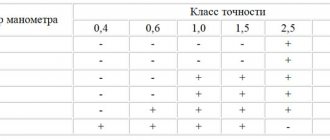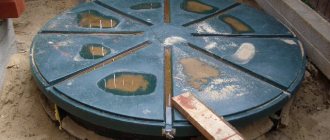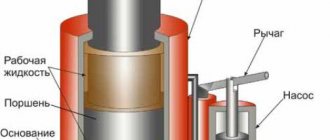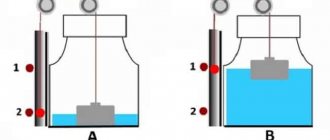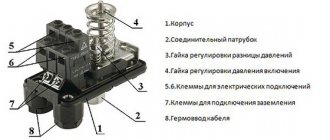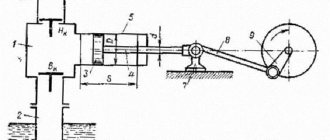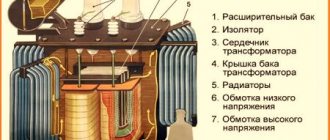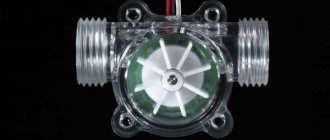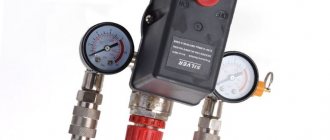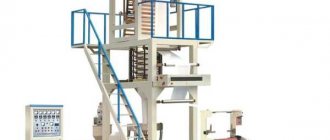Types and design of the device
Depending on the purposes for which the devices are used, they are divided into different types. The most common are spring pressure gauges. They have their advantages:
- Measuring quantities over a wide range.
- Good technical characteristics.
- Reliability.
- Simplicity of the device.
In a spring pressure gauge, the sensing element is a hollow, curved tube inside. It can have a cross-section in the form of an oval or an ellipsoid. This tube deforms under pressure . It is sealed on one side, and on the other there is a fitting with which the value in the medium is measured. The end of the tube, which is sealed, is connected to the transmission mechanism.
The design of the device is as follows:
- Frame.
- Instrument arrows.
- Gears.
- Axis.
- Leash.
- Gear sector.
A special spring is installed between the teeth of the sector and the gear, which is necessary in order to eliminate backlash.
The measuring scale is presented in Bars or Pascals. The arrow shows the excess pressure of the medium in which the measurement is being taken.
The principle of operation is very simple. The pressure from the medium being measured enters the tube. Under its influence, the tube tries to level out, since the area of the outer and inner surfaces has different sizes. The free end of the tube moves, and the arrow rotates at a certain angle thanks to a transmission mechanism. The measured value and the tube deformation are in a linear relationship. That is why the value that the arrow shows is the pressure of a certain environment.
Types of pressure measurement systems
There are many different pressure gauges for measuring low and high pressure. But their technical characteristics are different. The main distinguishing parameter is the accuracy class. The pressure gauge will show more accurately if the value is lower. The most accurate are digital devices.
According to their purpose, pressure gauges are of the following types:
- Self-recording. They contain a mechanism that allows you to draw a graph of the device’s operation on paper.
- Railway. Used in railway transport.
- Ship's. Used on sea and river vessels.
- Reference. They have a high accuracy class. That is why they are used for testing, adjusting and checking other pressure measuring instruments.
- Special. Used to measure the value of various gases. Depending on what gas they are intended for, they have different body colors and marking letters: for measuring flammable gases - red, for non-flammable gases - black, yellow ammonia (A), white acetylene (Ac), blue oxygen (K).
- Electric contact. They have an electrical alarm that allows you to regulate the measured environment. These devices are divided into two types: based on an electrical contact attachment and with microswitches.
- General technical. Designed to measure pressure in various environments. They can measure excess and vacuum pressures.
Based on the principle of operation, the following types are distinguished:
- Piezoelectric. Based on the piezoelectric effect. A charge appears in a quartz crystal under mechanical action.
- Deformation. They are based on the deformation of the sensitive element (membrane, bellows, spring, etc.), which, when deformed, acts on the pointer.
- Liquid. Their basis is a tube filled with liquid. They can be of two types: with one or two tubes. Devices with two tubes are used to compare pressure in different environments.
- Piston. They consist of a cylinder with a piston inserted inside.
Liquid measurement systems
The value in these pressure gauges is measured by balancing the weight of the liquid column. A measure of pressure is the level of fluid in communicating vessels. These devices can measure values in the range of 10−105 Pa. They have found their application in laboratory conditions.
Read also: Main products of ferrous metallurgy
Essentially, it is a U-shaped tube containing a liquid with a higher specific gravity compared to the liquid in which the hydrostatic pressure is directly measured. This liquid is most often mercury.
This category includes working and general technical devices such as TV-510, TM-510. This category is the most in demand. They are used to measure the pressure of non-aggressive and non-crystallizing gases and vapors. Accuracy class of these devices: 1, 1.5, 2.5. They have found their application in production processes, in the transport of liquids, in water supply systems and in boiler rooms.
Electrical contact devices
This category includes pressure and vacuum gauges and vacuum gauges. They are intended for measuring the volume of gases and liquids, which are neutral in relation to brass and steel. Their design is the same as that of spring ones. The only difference is in the large geometric dimensions. Due to the design of the contact groups, the body of the electrical contact device is large. This device can influence the pressure in a controlled environment by opening/closing contacts.
Thanks to the electrical contact mechanism used, this device can be used in an alarm system.
Reference meters
This device is intended for testing pressure gauges that measure values in laboratory conditions. Their main purpose is to check the serviceability of these working pressure gauges. A distinctive feature is a very high accuracy class. It is achieved thanks to design features and gearing in the transmission mechanism.
Special devices
These devices are used in various industrial sectors to measure the pressure of gases such as acetylene, oxygen, hydrogen, ammonia and others. Basically, pressure can be measured with a special pressure gauge for only one type of gas. Each device indicates the gas for which it is intended. The device is also colored to match the gas for which it can be used. The initial letter of gas is also written.
There are also vibration-resistant special pressure gauges that are capable of operating under strong vibrations and high pulsating environmental pressure. If you use a regular pressure gauge in such conditions, it will quickly break, since the transmission mechanism will fail. The main criterion for such devices is corrosion-resistant steel housing and tightness.
Ammonia systems must be corrosion resistant. Copper alloys are not allowed in the manufacture of acetylene measuring mechanisms. This is due to the fact that upon contact with acetylene there is a risk of formation of acetylene explosive copper. Oxygen mechanisms must be fat-free. This is due to the fact that in some cases even minor contact of pure oxygen and a contaminated mechanism can cause an explosion.
Recording devices
A distinctive feature of such devices is that they are able to record the measured pressure on a diagram, which will allow you to see changes at a certain time. They have found their application in industry with non-aggressive means and energy.
Ship and railway
Marine pressure gauges are designed to measure the vacuum pressure of liquids (water, diesel fuel, oil), steam and gas. Their distinctive features are high moisture protection, resistance to vibration and climatic influences. They are used in river and sea transport.
Railway gauges, unlike conventional pressure gauges, do not display pressure, but convert it into a signal of another type (pneumatic, digital, etc.). Various methods are used for these purposes.
Such converters are actively used in automation systems and process control. But despite their purpose, they are actively used in the nuclear energy, chemical and oil production industries.
Operating principle of a liquid pressure gauge
In the initial position, the water in the tubes will be at the same level. If pressure is applied to the rubber film, the liquid level in one elbow of the pressure gauge will decrease, and in the other, therefore, it will increase.
This is shown in the picture above. We press on the film with our finger.
When we press on the film, the air pressure in the box increases. Pressure is transmitted through the tube and reaches the liquid, displacing it. As the level in this elbow decreases, the fluid level in the other elbow of the tube will increase.
By the difference in liquid levels, it will be possible to judge the difference between atmospheric pressure and the pressure exerted on the film.
The following figure shows how to use a liquid pressure gauge to measure the pressure in a liquid at various depths.
Types of measuring instruments
Instruments for measuring pressure are divided into the following types:
- Thrust and pressure gauges are pressure and vacuum gauges that have extreme measurement limits of no higher than 40 kPa.
- Traction gauges are a vacuum gauge that has a measurement limit of (-40) kPa.
- A pressure gauge is a pressure gauge of low excess pressure (+40) kPa.
- Pressure and vacuum gauges are devices that are capable of measuring both vacuum and excess pressure in the range of 60–240,000 kPa.
- A vacuum gauge is a device that measures vacuum (pressure that is below atmospheric pressure).
- A pressure gauge is a device that is capable of measuring excess pressure, that is, the difference between absolute pressure and barometric pressure. Its limits range from 0.06 to 1000 MPa.
Read also: Service life of lithium-ion screwdriver batteries
Most imported and domestic pressure gauges are manufactured according to all generally accepted standards. It is for this reason that it is possible to replace one brand with another.
When choosing a device, you must rely on the following indicators:
- The location of the fitting is axial or radial.
- The diameter of the fitting thread.
- Instrument accuracy class.
- Case diameter.
- Limit of measured values.
Ionization pressure gauge
Ionization pressure gauges are the most sensitive measuring instruments for very low pressure. They make measurements indirectly by measuring those ions that are formed when gases are bombarded with electrons. The lower the gas density, the fewer ions will be formed. The calibration of the ionization pressure gauge is unstable. It depends on the nature of the gas being measured. But this nature is not always known. They can be calibrated by comparison with the values of the McLeod pressure gauge, which are independent of chemistry and more stable.
Thermoelectrodes with gas atoms collide and regenerate ions. They are attracted to the electrode at a voltage that is suitable for them (this suitable voltage is called a collector). In the collector, the current is proportional to the ionization rate, which in the system is a function of pressure. This is how gas pressure can be determined by measuring collector current.
Most ion pressure gauges are divided into three types:
- Cold cathode.
- Hot cathode. An electrically heated filament produces an electron beam. In this case, electrons pass through the device and ionize gas molecules around them. The ions that are formed accumulate on the electrode with a negative charge.
- A device with a rotating rotor. It is distinguished by its high price and sensitivity.
Calibration of ion pressure gauges is very sensitive to the chemical composition of the measured gases, structural geometry, surface deposits and corrosion. Their calibration may become unusable if switched on in a very low or atmospheric pressure environment.
It is necessary to measure pressure in many industrial sectors, but different instruments are used for this. But regardless of this, this value is not determined by anything other than a pressure gauge.
The operating principle is based on balancing the measured pressure or pressure difference with the pressure of a liquid column. They have a simple design and high measurement accuracy, and are widely used as laboratory and calibration instruments. Liquid pressure gauges are divided into: U-shaped, bell and ring.
U-shaped. The principle of operation is based on the law of communicating vessels. They come in two-pipe (1) and single-pipe cups (2).
1) 2)
1) are a glass tube 1 mounted on a board 3 with a scale and filled with a barrier liquid 2. The difference in levels in the elbows is proportional to the measured pressure drop. “-” 1. series of errors: due to inaccuracy in measuring the position of the meniscus, changes in T surrounding. environment, capillarity phenomena (eliminates by introducing corrections). 2. the need for two readings, which leads to an increase in error.
2) rep. is a modification of two-pipe ones, but one elbow is replaced with a wide vessel (cup). Under the influence of excess pressure, the liquid level in the vessel decreases and in the tube increases.
Float U-shaped differential pressure gauges are similar in principle to cup differential pressure gauges, but to measure pressure they use the movement of a float placed in a cup when the liquid level changes. By means of a transmission device, the movement of the float is converted into the movement of the indicating arrow. “+” wide measurement range.
Bell pressure gauges. Used to measure pressure drops and vacuums.
In this device there is a bell 1, suspended on a
carefully stretched spring 2, is partially immersed in separating liquid 3, poured into vessel 4. When P1 = P2, the bell of the device will be in equilibrium. When a pressure difference occurs, equilibrium will be disrupted and a lifting force will appear. will move the bell. As the bell moves, the spring compresses.
Ring pressure gauges. They are used to measure pressure differences, as well as small pressures and vacuums. The action is based on the principle of “ring scales”.
The operating principle is based on balancing the measured pressure or pressure difference with the pressure of a liquid column. They have a simple design and high measurement accuracy, and are widely used as laboratory and calibration instruments. Liquid pressure gauges are divided into: U-shaped, bell and ring.
U-shaped.
The principle of operation is based on the law of communicating vessels. They come in two-pipe (1) and single-pipe cups (2).
Read also: How to connect spotlights correctly
1) are a glass tube 1 mounted on a board 3 with a scale and filled with a barrier liquid 2. The difference in levels in the elbows is proportional to the measured pressure drop. “-” 1. series of errors: due to inaccuracy in measuring the position of the meniscus, changes in T surrounding. environment, capillarity phenomena (eliminates by introducing corrections). 2. the need for two readings, which leads to an increase in error.
2) rep. is a modification of two-pipe ones, but one elbow is replaced with a wide vessel (cup). Under the influence of excess pressure, the liquid level in the vessel decreases and in the tube increases.
Float U-shaped
Differential pressure gauges are similar in principle to cup gauges, but to measure pressure they use the movement of a float placed in a cup when the liquid level changes.
By means of a transmission device, the movement of the float is converted into the movement of the indicating arrow. “+” wide measurement range. The operating principle of liquid pressure
gauges is based on Pascal's law - the measured pressure is balanced by the weight of the working fluid column:
P = ρgh
. Consist of a reservoir and a capillary. Distilled water, mercury, and ethyl alcohol are used as working fluids. They are used for measuring small excess pressures and vacuum, barometric pressure. They are simple in design, but there is no remote data transmission.
Sometimes, to increase sensitivity, the capillary is placed at a certain angle to the horizon. Then: P = ρgL Sinα.
In deformation
pressure gauges are used to counter the elastic deformation of the sensing element (SE) or the force developed by it. There are three main forms of SE that have become widespread in measurement practice: tubular springs, bellows and membranes.
Tubular spring
(gauge spring, Bourdon tube) - an elastic metal tube, one of the ends of which is sealed and has the ability to move, and the other is rigidly fixed. Tubular springs are used primarily to convert the measured pressure applied to the interior of the spring into proportional movement of its free end.
The most common is a single-turn tubular spring, which is a 270° bent tube with an oval or elliptical cross-section. Under the influence of the supplied excess pressure, the tube unwinds, and under the influence of vacuum it twists. This direction of movement of the tube is explained by the fact that, under the influence of internal excess pressure, the minor axis of the ellipse increases, while the length of the tube remains constant.
The main disadvantage of the springs considered is their small angle of rotation, which requires the use of transmission mechanisms. With their help, moving the free end of a tubular spring by several degrees or millimeters is converted into an angular movement of the arrow by 270 - 300°.
The advantage is a static characteristic close to linear. The main application is indicating instruments. Measurement ranges of pressure gauges from 0 to 10 3 MPa; vacuum gauges - from 0.1 to 0 MPa. Instrument accuracy classes: from 0.15 (exemplary) to 4.
Tubular springs are made of brass, bronze, and stainless steel.
Bellows
. Bellows is a thin-walled metal cup with transverse corrugations. The bottom of the glass moves under pressure or force.
Within the linearity of the static characteristics of the bellows, the ratio of the force acting on it to the deformation caused by it remains constant. and is called the rigidity of the bellows. Bellows are made from various grades of bronze, carbon steel, stainless steel, aluminum alloys, etc. Bellows with a diameter of 8–10 to 80–100 mm and a wall thickness of 0.1–0.3 mm are mass-produced.
Membranes
. There are elastic and elastic membranes. An elastic membrane is a flexible round flat or corrugated plate that can bend under pressure.
The static characteristic of flat membranes changes nonlinearly with increasing pressure, therefore a small part of the possible stroke is used as the working area. Corrugated membranes can be used for larger deflections than flat ones, since they have significantly less nonlinearity of the characteristic. Membranes are made from various grades of steel: bronze, brass, etc.
This page was last modified: 2016-08-06; Page copyright infringement
Diaphragm pressure gauges (vacuum gauges) for measuring pressure in vacuum systems
In a membrane pressure gauge, the main working element is a flat or corrugated membrane. The membrane bends under the influence of the pressure difference, and its deformation is transmitted to the arrow using a transmission mechanism. The disadvantage of the pressure gauge is the small deflection of the membrane (maximum 1.5-2 mm). However, the pressure gauge is widely used because it is less sensitive to shock and shaking and is less susceptible to clogging than the Bourdon pressure gauge.
In Fig. 463 shows a membrane pressure gauge with an electric remote indicator, allowing remote reading and recording of pressures. The pressure gauge can work in vacuum installations with automatic control. The range of measured pressures is from 0.1 mm Hg. Art. to atmospheric. The deflection of the membrane is transmitted through a system of levers to a coil located between the poles of an electromagnet powered by alternating current. When the coil is rotated, an e is induced in it. d. s, which is transmitted to the amplifier and then measured by a pointer device.
When using a membrane box instead of a single membrane, the sensitivity of the device increases as the deformation of the membrane increases. If you use a bellows instead of a membrane box, you can significantly expand the limit of measured pressures. It should be noted that, compared to liquid pressure gauges, membrane pressure gauges are more sensitive, convenient to read and reliable in operation. The measurement results do not depend on the type of residual gases. A pressure gauge with two rigidly connected membranes (double-balloon) allows you to measure and record pressures from 0.1 to 400 mm Hg. Art. with an accuracy of ±5%. A pressure of 1O-3 - 1O-8 mm Hg is maintained over one membrane. Art. (reference vacuum), the measured pressure acts on the other membrane.
The movement of the entire system under the influence of a pressure difference is measured by a mechatronic micrometer, the readings of which are measured using a microammeter. The maximum movement of the moving system is 0.5 mm.
Membrane measuring instruments of the GDR (Hohvacuum Dresden) with direct or remote measurement operate independently of atmospheric pressure and are designed to measure pressures from atmospheric to 1 mmHg. Art.
The CG3 membrane pressure gauge from Edwards (England) is designed to measure pressures from 0 to 20, from 0 to 40, from 0 to 100 and from 0 to 760 mm Hg. Art. The measuring part of the pressure gauge is directly connected to the volume being pumped out, so it is not suitable for measuring pressures in high humidity or in heavily contaminated systems. The pressure gauge is designed as follows: after pumping, a sealed aneroid, mechanically connected to the pressure gauge needle, is placed inside a chamber directly connected to the vacuum system.
Scale diameter 76 mm. Membrane pressure gauges from Leibold (Germany) measure pressures from 400 to 1 mm Hg. Art., Bourdon spring pressure gauges - from 760 to 20 mm Hg. Art. The readings of membrane pressure gauges do not depend on atmospheric pressure.

